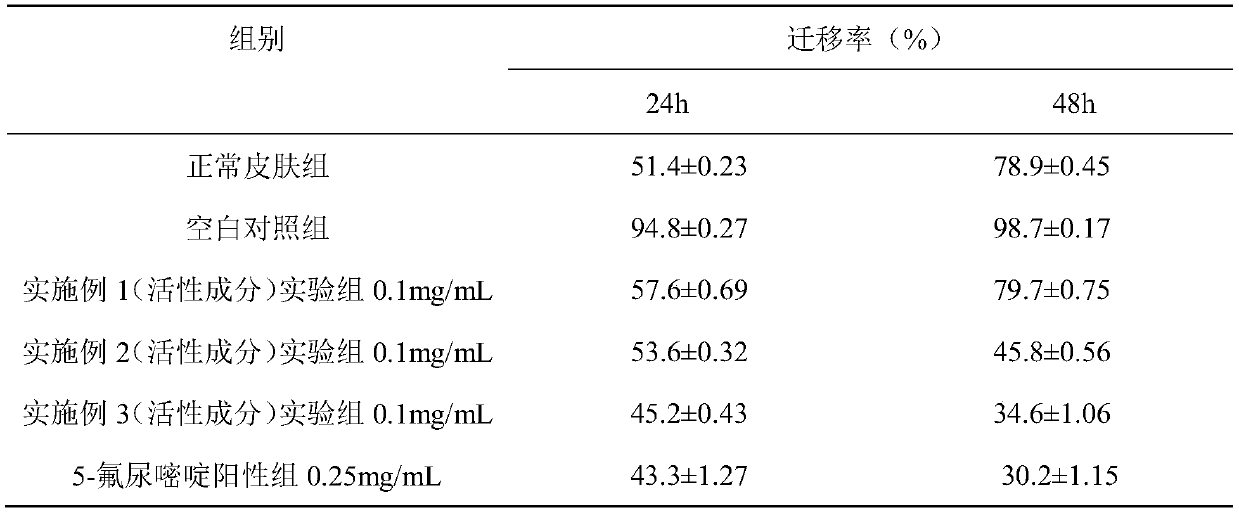Scar repair ointment and preparation method thereof
An ointment and scar technology, applied in the field of medical cosmetology, can solve problems such as skin damage, unknown ingredients, improper use by consumers, etc., and achieve the effects of promoting cell regeneration, good bioavailability, and preventing scars and acne marks.
- Summary
- Abstract
- Description
- Claims
- Application Information
AI Technical Summary
Problems solved by technology
Method used
Image
Examples
preparation example Construction
[0040] Two, the preparation of glycyrrhetinic acid monoglucuronide
[0041] (1) Place the glycyrrhizic acid of 1 mass part in the reactor, add the ionic liquid of 8 mass parts, the ionic liquid cation is 1-ethyl-3 methylimidazole [Emim] + , the ionic liquid anion is BF 4- The 1-ethyl-3-methylimidazolium tetrafluoroborate is stirred and dissolved to obtain a solution;
[0042] (2) Add 0.4 parts by mass of catalyst concentrated sulfuric acid into the solution for reaction, the reaction temperature is 30°C, and the reaction time is 3h;
[0043] (3) After the reaction finishes, adjust the pH value to 8, and separate the lower floor water from the system;
[0044] (4) Concentrate the water solution to obtain a solid, and add organic solvent methanol to crystallize at a mass ratio of 1:8 to obtain glycyrrhetinic acid monoglucuronide.
[0045] 3. Preparation of scar repair ointment
Embodiment 1
[0046] Embodiment 1: The formula of scar repair ointment is as follows: the total amount is 100 parts by weight, A phase components: 80.77 parts of distilled water, 0.5 part of AVC, 0.02 part of hyaluronic acid, 0.1 part of allantoin, 0.15 part of p-hydroxybenzene Methyl formate; Phase B components: 5 parts olive oil, 2 parts isopropyl palmitate, 2 parts isooctyl palmitate, 1 part dimethicone, 0.5 parts olive oil emulsifying wax, 1.5 parts cetearyl Alcohol, 1 part of monoglyceride stearate, 1 part of jojoba oil, 1 part of squalane, 0.5 part of Pingpinga 25, 0.2 part of oil-soluble VE, 0.2 part of Span 60, 0.05 part of propylparaben; Phase C components: 0.1 part of glycyrrhetinic acid monoglucuronide, 0.2 parts of asiaticoside, 0.2 parts of phenoxyethanol; components of phase D: 0.01 parts of shikonin, 1 part of propylene glycol, 0.5 parts of lavender essential oil, 0.5 parts Evening primrose essential oil.
[0047] Preparation of Phase A: Weigh the distilled water, AVC, hyalu...
Embodiment 2
[0051] Embodiment 2: The formula of scar repair ointment is as follows: Based on the total amount of 100 parts by weight, A phase components: 77 parts of distilled water, 0.7 part of AVC, 0.03 part of hyaluronic acid, 0.2 part of allantoin, 0.1 part of p-hydroxybenzene Methyl formate; Phase B components: 6 parts olive oil, 3 parts isopropyl palmitate, 1 part isooctyl palmitate, 1.5 parts dimethicone, 0.8 parts olive oil emulsifying wax, 1 part cetearyl Alcohol, 0.5 part of monoglyceride stearate, 1 part of jojoba oil, 1 part of squalane, 1 part of Pingpinga 25, 0.4 part of oil-soluble VE, 0.4 part of Span 60, 0.06 part of propyl paraben; Phase C components: 0.15 parts of glycyrrhetinic acid monoglucuronide, 0.3 parts of asiaticoside, 0.3 parts of phenoxyethanol; components of phase D: 0.01 parts of shikonin, 1.5 parts of propylene glycol, 1 part of lavender essential oil, 1 part Evening primrose essential oil.
[0052] Preparation of Phase A: Weigh the formula quantities of d...
PUM
 Login to View More
Login to View More Abstract
Description
Claims
Application Information
 Login to View More
Login to View More - R&D
- Intellectual Property
- Life Sciences
- Materials
- Tech Scout
- Unparalleled Data Quality
- Higher Quality Content
- 60% Fewer Hallucinations
Browse by: Latest US Patents, China's latest patents, Technical Efficacy Thesaurus, Application Domain, Technology Topic, Popular Technical Reports.
© 2025 PatSnap. All rights reserved.Legal|Privacy policy|Modern Slavery Act Transparency Statement|Sitemap|About US| Contact US: help@patsnap.com



